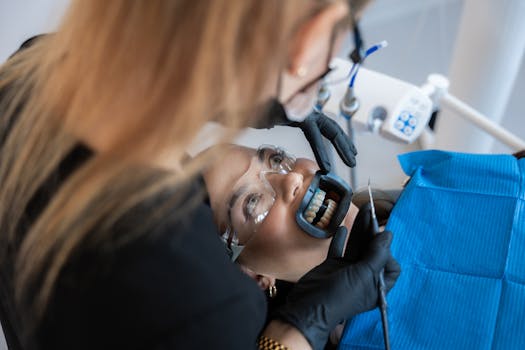Are my teeth just discoloured or do I have cavities?
Do you ever worry that your teeth are more than just discoloured? Are there signs of tooth decay in your mouth that you don't notice? In this blog post, we'll look at what causes tooth discolouration and how you can tell if it's a sign of deeper dental disease like tooth decay. We also explain how you can prevent problems and maintain a healthy smile.



What is discolouration?
Tooth discolouration is a change in tooth colour that usually only affects the surface of the tooth. It can be caused by various factors, such as dark foods and drinks like coffee, tea or red wine, or habits like smoking or other tobacco use. Discolouration can range from yellowing to darker brown stains on the teeth.
Likewise, discolouration of the teeth can be caused by inadequate dental hygiene. This is because if particles from food and drink get trapped and are not adequately removed, teeth can become discoloured over time. Read more about discolouration and yellow teeth here.
How can I prevent discolouration?
One of the best ways to prevent tooth discolouration is to maintain good oral hygiene and a healthy lifestyle. Brushing twice a day for two minutes with fluoride toothpaste and flossing at least once a day helps remove plaque, which can cause discolouration. Reducing or eliminating sugary foods and drinks and tobacco products can also help reduce the risk of discolouration.
Prevent discolouration with ALPINE WHITE
Use our whitening products to gently and sustainably whiten your teeth. With our Whitening Strips, you can easily remove discolouration in the early stages within 7 days. Also use our Whitening Toothpaste for optimal dental health and healthy gums.
Come to our ALPINE WHITE Studio and have your teeth professionally cleaned by our dental staff. If you have brownish discolouration, you can have our tooth-friendly in-office bleaching to lighten the affected areas even more.
What is caries?
Tooth decay is an infection of the tooth that leads to damage to the tooth structure such as enamel, dentin and root. Incipient caries are caused by certain bacteria deposited in plaque (dental plaque) on the teeth. If this plaque is not removed by regular brushing and flossing, it leads to the formation of acids that attack the enamel over time. This weakens the teeth and creates gum pockets where even more plaque can accumulate, leading to further decay. When tooth decay develops (initial caries), yellow or brown spots or lines appear on your teeth. If left untreated, tooth decay can lead to toothache, infection and, in severe cases, even loss of teeth.
The baby teeth, often the incisors, are particularly vulnerable to decay in young children. Therefore, it is important that children learn proper dental care at an early age and that their teeth are checked regularly.
The development of caries
Tooth decay occurs when the bacteria on the surface and between the teeth are not removed regularly. The bacteria consist of different types of acids that attack the tooth enamel, weakening it and thus leading to small holes or cavities in the enamel. When cavities form, they appear as yellow or brown spots on the teeth. However, the affected teeth do not necessarily have to be darkly discoloured; white spots can also form, which can be a sign of tooth decay.
If no action is taken, plaque can continue to build up on teeth with existing decay. Not only do new cavities form, but existing cavities can become deeper and more painful without proper treatment. In addition, decay can not only attack the outer layer of a tooth, but also damage the dentin (the layer under the enamel), the cementum (the protective layer of the tooth root), the underlying pulp and the tooth nerve.
Is a black spot on the tooth caries?
A black spot on the tooth may indicate caries or it may be discolouration. Most of the time, however, black spots are just discoloured fissures that do not need to be treated with a drill. They can be whitened by regular brushing, professional teeth cleaning and fluoridation.
However, caries also starts as small spots on the surface of the teeth and can become larger over time if left untreated.
To differentiate between a black spot caused by decay and a black spot caused by discolouration, it is best to visit our studio for an Oral Health Checkup or Dental Hygiene. This way we can help you in the best possible way.
How can I prevent caries?
To limit the risk of tooth decay, it is important to have regular check-ups at our studio in addition to optimal dental cleaning. Good oral hygiene helps to remove plaque and tartar, which can cause tooth decay.
In addition, the use of products such as sealants and fluoridated mouthwashes can help prevent the development of tooth decay. Sealants are thin coatings applied to the surface of the molars that act like a shield against bacteria, while fluoride helps to remineralise weakened tooth enamel, making it stronger and less likely to form cavities.
Through regular professional teeth cleaning at ALPINE WHITE Studio, we can detect cavities and refer you to a dentist or dental hygienist we trust.
The caries treatment procedure
There are different treatment options for tooth decay. These depend entirely on how advanced the caries is.
If caries is still in the early stages, fluoridation is sufficient. Fluoride, a mineral, is built into the tooth enamel and makes it more resistant to decay. You can take fluoride with a fluoride gel or toothpaste.
However, if the decay is more advanced, it will need to be removed at the dentist's office. The decayed substance is removed with a drill and filled with either an amalgam or a dental filling. In more severe cases of caries, a crown may be used to replace the entire tooth surface. If tooth decay is detected early enough, it can usually be treated effectively without damaging the tooth substance.
To prevent further damage, the dentist may also suggest preventive measures such as fluoride treatments, sealants and regular professional dental cleanings. These preventive measures help to reduce plaque build-up and strengthen weakened tooth enamel, which reduces your risk of getting cavities in the future.


